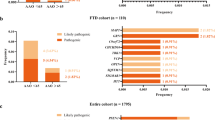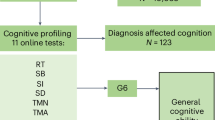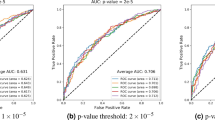Abstract
Genetic influences have an important role in the ageing process. The genetic factors that influence success in bodily ageing may also contribute to the successful ageing of cognitive abilities. A comparative genomics approach found longevity genes conserved between yeast Saccharomyces cerevisiae and nematode Caenorhabditis elegans. We hypothesised that these longevity genes influence variance in cognitive ability and age-related cognitive decline in humans. Here, we investigated six of these genes that have human orthologs and show expression in the brain. We tested AFG3L2 (MIM: 604581, AFG3 ATPase family gene 3-like 2 (yeast)), FRAP1 (MIM: 601231, a FK506 binding protein 12-rapamycin associated protein), MAT1A, MAT2A (MIM: 610550 and 601468, methionine adenosyltransferases I alpha and II alpha, respectively), SYNJ1 and SYNJ2 (MIM: 604297 and 609410, synaptojanin-1 and synaptojanin-2, respectively) in approximately 1000 healthy older Scots: the Lothian Birth Cohort 1936 (LBC1936). They were tested on general cognitive ability at age 11 years. At a mean age of 70 years, they re-sat the same general cognitive ability test and underwent an additional battery of diverse cognitive tests. In all, 70 tag and functional SNPs in the six longevity genes were genotyped and tested for association with cognition and cognitive ageing in LBC1936. Suggestive associations were detected between SNPs in SYNJ2, MAT1A, AFG3L2 and SYNJ1 and a general memory factor and general cognitive ability at age 11 and 70 years. Replication studies for cognitive ability associations were performed in 2506 samples from the Cognitive Ageing Genetics in England and Scotland consortium. A meta-analysis replicated the SYNJ2 association with cognitive abilities (lowest P=0.00077). SYNJ2 is a novel gene in which variation is potentially associated with cognitive abilities.
Similar content being viewed by others
Log in or create a free account to read this content
Gain free access to this article, as well as selected content from this journal and more on nature.com
or
References
Ho L : Ageing: Scientific Aspects. London, UK, 2005.
Melzer D, McWilliams B, Brayne C, Johnson T, Bond J : Profile of disability in elderly people: estimates from a longitudinal population study. BMJ 1999; 318: 1108–1111.
Deary IJ : Individual differences in cognition: British contributions over a century. Br J Psychol 2001; 92: 217–237.
Wilson RS, Beckett LA, Barnes LL et al: Individual differences in rates of change in cognitive abilities of older persons. Psychol Aging 2002; 17: 179–193.
Deary IJ, Corley J, Gow AJ et al: Age-associated cognitive decline. Br Med Bull 2009; 92: 135–152.
Fillit HM, Butler RN, O’Connell AW et al: Achieving and maintaining cognitive vitality with aging. Mayo Clin Proc 2002; 77: 681–696.
Deary IJ, Johnson W, Houlihan LM : Genetic foundations of human intelligence. Hum Genet 2009; 126: 215–232.
Calvin CM, Deary IJ, Fenton C et al: Intelligence in youth and all-cause-mortality: systematic review with meta-analysis. Int J Epidemiol 2011; 40: 626–644.
Der G, Batty GD, Deary IJ : The association between IQ in adolescence and a range of health outcomes at 40 in the 1979 US National Longitudinal Study of Youth. Intelligence 2009; 37: 573–580.
Christensen H, Mackinnon AJ, Korten A, Jorm AF : The ‘common cause hypothesis’ of cognitive aging: evidence for not only a common factor but also specific associations of age with vision and grip strength in a cross-sectional analysis. Psychol Aging 2001; 16: 588–599.
Maier H, McGue M, Vaupel JW, Christensen K : Cognitive Impairment and Survival at Older Ages. Berlin: Springer, 2003.
Batty GD, Deary IJ, Gottfredson LS : Premorbid (early life) IQ and later mortality risk: systematic review. Ann Epidemiol 2007; 17: 278–288.
Deary I : Why do intelligent people live longer? Nature 2008; 456: 175–176.
Mitchell BD, Hsueh WC, King TM et al: Heritability of life span in the Old Order Amish. Am J Med Genet 2001; 102: 346–352.
Kirkwood TB, Feder M, Finch CE et al: What accounts for the wide variation in life span of genetically identical organisms reared in a constant environment? Mech Ageing Dev 2005; 126: 439–443.
Partridge L : The new biology of ageing. Philos Trans R Soc Lond Ser B 2010; 365: 147–154.
Smith ED, Tsuchiya M, Fox LA et al: Quantitative evidence for conserved longevity pathways between divergent eukaryotic species. Genome Res 2008; 18: 564–570.
Shmueli O, Horn-Saban S, Chalifa-Caspi V et al: GeneNote: whole genome expression profiles in normal human tissues. C R Biol 2003; 326: 1067–1072.
Deary IJ, Whiteman MC, Starr JM, Whalley LJ, Fox HC : The impact of childhood intelligence on later life: following up the Scottish mental surveys of 1932 and 1947. J Pers Soc Psychol 2004; 86: 130–147.
Deary IJ, Whalley LJ, Starr JM : A Lifetime of Intelligence: Follow-up Studies of the Scottish Mental Surveys of 1932 and 1947. Washington, DC: American Psychological Association, 2009.
Rabbitt PMA, McInnes L, Diggle P et al: The University of Manchester longitudinal study of cognition in normal healthy old age, 1983 through 2003. Aging Neuropsychol Cogn 2004; 11: 245–279.
Scottish Council for Research in Education: Mental Survey Committee; in Thomson GH (ed): Scottish Council for Research in Education: The Trend of Scottish Intelligence: A Comparison of the 1947 and 1932 Surveys of the Intelligence of Eleven-Year-Old Pupils. London: University of London Press, 1949.
Deary IJ, Gow AJ, Taylor MD et al: The Lothian Birth Cohort 1936: a study to examine influences on cognitive ageing from age 11 to age 70 and beyond. BMC Geriatr 2007; 7: 28.
Folstein MF, Folstein SE, McHugh PR : ‘Mini-mental state’. A practical method for grading the cognitive state of patients for the clinician. J Psychiatr Res 1975; 12: 189–198.
Anderson TM, Sachdev PS, Brodaty H, Trollor JN, Andrews G : Effects of sociodemographic and health variables on Mini-Mental State Exam scores in older Australians. Am J Geriatr Psychiatry 2007; 15: 467–476.
Davies G, Tenesa A, Payton A et al: Genome-wide association studies establish that human intelligence is highly heritable and polygenic. Mol Psychiatry 2011; 16: 996–1005.
Wechsler D : WMS-III: Wechsler Memory Scale Administration and Scoring Manual. Psychological Corp (1997) London, UK, 1998.
Deary IJ, Der G, Ford G : Reaction times and intelligence differences – a population-based cohort study. Intelligence 2001; 29: 389–399.
de Bakker PI, Yelensky R, Pe’er I, Gabriel SB, Daly MJ, Altshuler D : Efficiency and power in genetic association studies. Nat Genet 2005; 37: 1217–1223.
Barrett JC, Fry B, Maller J, Daly MJ : Haploview: analysis and visualization of LD and haplotype maps. Bioinformatics 2005; 21: 263–265.
Li Y, Willer CJ, Ding J, Scheet P, Abecasis GR : MaCH: using sequence and genotype data to estimate haplotypes and unobserved genotypes. Genet Epidemiol 2010; 34: 816–834.
Luciano M, Hansell N, Lahti J et al: Whole genome association scan for genetic polymorphisms influencing information processing speed. Biol Psychol 2011; 86: 193–202.
Houlihan LM, Davies G, Tenesa A et al: Common variants of large effect in F12, KNG1, and HRG are associated with activated partial thromboplastin time. Am J Hum Genet 2010; 86: 626–631.
Luciano M, Gow AJ, Hayward C et al: Cognitive aging from age 11 to 70 years, information processing speed, and APOE variation: the Lothian Birth Cohort 1936 Study. Psychol Aging 2009; 24: 129–138.
Houlihan LM, Wyatt ND, Harris SE et al: Variation in the uric acid transporter gene (SLC2A9) and memory performance. Hum Mol Genet 2010; 19: 2321–2330.
Houlihan LM, Harris SE, Luciano M et al: Replication study of candidate genes for cognitive abilities: the Lothian Birth Cohort 1936. Genes Brain Behav 2009; 8: 238–247.
Johnson W, te Nijenhuis J, Bouchard TJ : Still just 1 g: consistent results from five test batteries. Intelligence 2008; 36: 81–95.
Purcell S, Neale B, Todd-Brown K et al: PLINK: a tool set for whole-genome association and population-based linkage analyses. Am J Hum Genet 2007; 81: 559–575.
Li Y, Willer C, Sanna S, Abecasis G : Genotype imputation. Annu Rev Genom Hum Genet 2009; 10: 387–406.
Willer CJ, Li Y, Abecasis GR : METAL: fast and efficient meta-analysis of genomewide association scans. Bioinformatics 2010; 26: 2190–2191.
Shen Q, Zhang Z, Yu L et al: Common variants near TERC are associated with leukocyte telomere length in the Chinese Han population. Eur J Hum Genet 2011; 19: 721–723.
Perneger TV : What's wrong with Bonferroni adjustments. BMJ 1998; 316: 1236–1238.
Nyholt DR : A simple correction for multiple testing for single-nucleotide polymorphisms in linkage disequilibrium with each other. Am J Hum Genet 2004; 74: 765–769.
Purcell S, Cherny SS, Sham PC : Genetic Power Calculator: design of linkage and association genetic mapping studies of complex traits. Bioinformatics 2003; 19: 149–150.
Nemoto Y, Wenk MR, Watanabe M et al: Identification and characterization of a synaptojanin 2 splice isoform predominantly expressed in nerve terminals. J Biol Chem 2001; 276: 41133–41142.
Datson NA, Morsink MC, Steenbergen PJ et al: A molecular blueprint of gene expression in hippocampal subregions CA1, CA3, and DG is conserved in the brain of the common marmoset. Hippocampus 2009; 19: 739–752.
Aston C, Jiang L, Sokolov BP : Transcriptional profiling reveals evidence for signaling and oligodendroglial abnormalities in the temporal cortex from patients with major depressive disorder. Mol Psychiatry 2005; 10: 309–322.
Laumonnier F, Cuthbert PC, Grant SG : The role of neuronal complexes in human X-linked brain diseases. Am J Hum Genet 2007; 80: 205–220.
Nagamani SC, Erez A, Eng C et al: Interstitial deletion of 6q25.2–q25.3: a novel microdeletion syndrome associated with microcephaly, developmental delay, dysmorphic features and hearing loss. Eur J Hum Genet 2009; 17: 573–581.
Burger C, Lopez MC, Feller JA, Baker HV, Muzyczka N, Mandel RJ : Changes in transcription within the CA1 field of the hippocampus are associated with age-related spatial learning impairments. Neurobiol Learn Mem 2007; 87: 21–41.
Nemoto Y, Arribas M, Haffner C, DeCamilli P : Synaptojanin 2, a novel synaptojanin isoform with a distinct targeting domain and expression pattern. J Biol Chem 1997; 272: 30817–30821.
Zollner S, Pritchard JK : Overcoming the winner's curse: estimating penetrance parameters from case–control data. Am J Hum Genet 2007; 80: 605–615.
Acknowledgements
We thank the cohort participants and team members who contributed to these studies. Genotyping of the CAGES cohorts and the analyses conducted here were supported by the UK's Biotechnology and Biological Sciences Research Council (BBSRC). Phenotype collection in the Lothian Birth Cohort 1936 was supported by Research Into Ageing (continues as part of Age UK's The Disconnected Mind project). Phenotype collection in the Lothian Birth Cohort 1921 was supported by the BBSRC, The Royal Society and The Chief Scientist Office of the Scottish Government. Phenotype collection in the Aberdeen Birth Cohort 1936 was supported by BBSRC, the Welcome Trust and the Alzheimer's Research trust. Phenotype collection in the Manchester and Newcastle Longitudinal Studies of Cognitive Aging cohorts was supported by Social Science Research Council, Medical Research Council, Economic and Social Research Council, Research Into Ageing, Wellcome Trust and Unilever plc. LML is supported by AXA Research Fund during some of this work. ML is a Royal Society of Edinburgh/Lloyds TSB Foundation for Scotland Personal Research Fellow. The work was undertaken in The University of Edinburgh Centre for Cognitive Ageing and Cognitive Epidemiology, part of the cross council Lifelong Health and Wellbeing Initiative (G0700704/84698). Funding from the BBSRC, EPSRC, ESRC and MRC is gratefully acknowledged.
Author Contributions
Data analysis: Lopez. Study design: Lopez and Deary. Manuscript Preparation: Lopez, Deary, Harris, Luciano, Gow, Starr and Pendleton. Individual study design/management: Tenesa, Payton, Ke, Whalley, Fox, Ollier, Pickles, Porteous, Horan, Pendleton, Starr and Deary. Genetic preparation: Lopez, Liewald, Davies, Harris, Luciano and Tenesa. Phenotype preparation: Lopez, Luciano, Gow, Payton, Ke, Whalley, Fox, Ollier, Pickles, Horan, Pendleton, Starr and Deary. Manuscript review: Lopez, Harris, Luciano, Liewald, Davies, Gow, Tenesa, Payton, Ke, Whalley, Fox, Ollier, Pickles, Porteous, Horan, Pendleton, Starr and Deary.
Author information
Authors and Affiliations
Corresponding author
Ethics declarations
Competing interests
The authors declare no conflict of interest.
Additional information
Supplementary Information accompanies the paper on European Journal of Human Genetics website
Supplementary information
Rights and permissions
About this article
Cite this article
Lopez, L., Harris, S., Luciano, M. et al. Evolutionary conserved longevity genes and human cognitive abilities in elderly cohorts. Eur J Hum Genet 20, 341–347 (2012). https://doi.org/10.1038/ejhg.2011.201
Received:
Revised:
Accepted:
Published:
Issue date:
DOI: https://doi.org/10.1038/ejhg.2011.201
Keywords
This article is cited by
-
Multifaceted Roles of AFG3L2, a Mitochondrial ATPase in Relation to Neurological Disorders
Molecular Neurobiology (2023)
-
SYNJ2 is a novel and potential biomarker for the prediction and treatment of cancers: from lung squamous cell carcinoma to pan-cancer
BMC Medical Genomics (2022)
-
Hippocampal CA3 transcriptional modules associated with granule cell alterations and cognitive impairment in refractory mesial temporal lobe epilepsy patients
Scientific Reports (2021)
-
Molecular pathways associated with the nutritional programming of plant-based diet acceptance in rainbow trout following an early feeding exposure
BMC Genomics (2016)
-
New roles for mitochondrial proteases in health, ageing and disease
Nature Reviews Molecular Cell Biology (2015)



